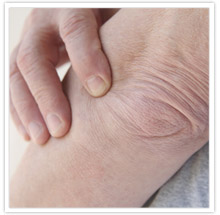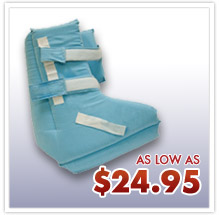
|
Protect Those Bony Prominences!
Although pressure ulcers develop most commonly on the sacrum, they can actually form anywhere that tissue is under constant pressure. That's why it's important that your pressure ulcer prevention arsenal contains support surfaces and devices.
Tissue that is closest to the bone is often the first to undergo necrosis, so it makes sense that pressure ulcers are commonly located over bony prominences. These can include the sacrum, heel, the greater trochanter (on the upper extremity of the femur), ischial tuberosity (commonly known as a "sitting bone"), fibular head (a bone on the interior of the knee), scapula (shoulder blade) and malleolus (ankle). These areas should receive special attention when developing a pressure ulcer prevention strategy.
|
Heels and elbows can be particularly tricky when it comes to pressure redistribution because they have relatively little surface area, but heel and elbow protectors have been shown to reduce friction and shearing as well as help keep bony prominences from rubbing together.1
When choosing a support surface or device, it's important to match the device's therapeutic benefit with the resident's specific needs. For example, static pressure redistribution devices (including solid foam, convoluted foam and gel mattresses) may be indicated when a resident is at risk for pressure ulcer development or delayed healing. On the other hand, dynamic pressure reduction surfaces are helpful when1:
- The resident can’t move from position to position without putting weight on a pressure ulcer;
- The resident completely compresses static devices that still have their original integrity or
- The resident’s pressure ulcer is not healing as expected and it’s been determined that pressure could be contributing to the delay in healing.
|
Reference
- Centers for Medicare & Medicaid Services. State Operations Manual. Appendix PP – Guidance to Surveyors for Long Term Care Facilities. Rev. 70, 01-07-11.
|

|
ProMed Easter Closure Notice
Our office will be closed on Friday, April 6 in honor of Good Friday/Easter. Orders that are placed by noon on Monday, April 2 will be delivered by Thursday, April 5. Orders placed after noon on April 2 will be delivered the following week.
If you have any questions at all, we invite you to contact our Customer Care team at 800.648.5190.
|
 |
 |



|
The Compliance® Heel Suspension Boot
is a heel offloading device that has been shown to significantly offset the expense of treating heel pressure ulcers. These devices don't just reduce friction and shear – they completely offload the heel while staying in place, even with resident movement.
Additional Features:
- Super-soft peachskin antimicrobial cloth protects thin, fragile skin from tears
- Adaptable hook and loop closures allow the boot to be secured at two alternate positions
- Extended and cushioned design distributes the weight of the heel over a larger area, reducing pressure and increasing blood flow
- CA 117 approved
- Available in Small, Medium and Large
|
Product pricing is only visible to registered promedsupply.com customers. If you are not yet registered, give us a call at (800) 648-5190 and our Customer Care Professionals will be happy to get you set up.
|
|






